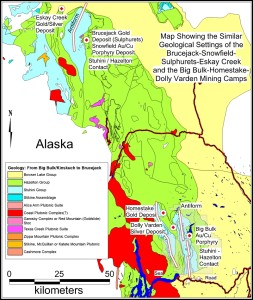Click here to download an April 2016 presentation on why the Big Bulk area is part of British Columbia’s Golden Triangle.
Click here to view and hear the presentation on YouTube.
The Big Bulk alkalic Au/Cu porphyry system is geologically very similar to the Sulphurets/Brucejack/Snowfield Au/Cu camp 100 kilometers to the north. Pretivm Resources Inc’s Brucejack Project has Proven and Probable reserves in the Valley of the Kings of 6.9 million ounces of gold (13.6 million tonnes grading 15.7 grams per tonne gold (www.pretivm.com)). The mine is now in full production.
In 2003, reporting for Teck Cominco, Graeme Evans described Big Bulk as follows:
“The Big Bulk area covers a large prominent gossanous area around the southern
and eastern sides of Kinskuch Lake. The 2002 mapping has shown this area occupies the
lower Hazelton volcanic sequence well below the Salmon River Fm. and the area has
extensive Cu-Au mineralization associated with a large subvolcanic “Goldslide” type
multiphase intrusive complex. In many ways this complex has many similarities to that of
the Sulphurets camp located 105 km’s to the NW and the Red Mtn. area located 35 km’s
to the NW as a diverse high level Cu-Au porphyry-epithermal system with several styles
of mineralization. These include widespread areas of Cu-Au porphyry style
mineralization with the unusual chlorite/sericite association, Au with advanced argillic
alteration and high grade Au-Ag epithermal vein systems, present over a 6.0+ square
kilometer area. Mineralization is complex with spatial and temporal relationships
reflecting a high level porphyry and transitional epithermal style system with several
styles of quartz vein and stockwork mineralization associated with pervasive
chlorite/sericite/pyrite and later sericite/pyrite mineralization. This system is a large
complex multiphase porphyry system with good potential for both bulk tonnage Cu-Au
and high grade gold potential.” [Evans, 2003]
After examining Durango Capital Corp drill core in 2008, Dr. Andre Panteleyev wrote of Big Bulk as follows:
“The geological setting and style of mineralization of Big Bulk, other than less
deformation, is similar to the Kerr porphyry copper-gold deposit in the Sulphurets
District (Ditson et al, 1995). Smaller zones of mineralization at Big Bulk in this high
level broad alteration zone are possibly similar to the Sulphurets District Brucejack gold
silver Au-Ag vein deposits and possibly the Snowfield auriferous quartz stockwork
mineralization (Margolis et al, 1995).” [Panteleyev, 2008]
After mapping the Big Bulk claims in 2017, Gayle Febbo, 2015 author of “Geology of the Mitchell Au-Cu-Ag-Mo porphyry deposit, northwestern British Columbia” wrote in her 2017 Assessment Report on the Big Bulk claims:
“New interpretations indicate that the system is tilted with a surface expression of over 3.5 Km. Given the dimensions of the system as well as the dioritic host rocks, Orevista geologists believe the target is a much larger calc-alkaline porphyry system. Given that the porphyry system is tilted on its side, deeper core zone alteration and mineralization normally only tested with deep drilling is present at surface.” [Page 26]
“This study correlates surface high copper and gold in historic rock samples to lie within zones of sheeted quartz veins that strongly resemble the Mitchell-Snowfield mineralization style. The vertical and lateral extent of the original stockwork body ~1.5 km is of comparable scale to the vertical extent of Mitchell- Snowfield as well. The interpretation of the porphyry tilt allows drillable access to root zones of the system that is normally not possible.” [Page 25]
Geologists from the British Columbia Geological Survey have published scholarly papers describing the likely controls (particularly the Stuhini/Hazelton contact) on alkalic Au/Cu mineralisation in British Columbia.
This research was highlighted in the Northern Miner in 2015. The Northern Miner article may be reached by clicking here.
Map showing the proximity of Big Bulk to the Stuhini/Hazelton contact (purple), and how extensive that contact is on the Kinskuch property. Click to enlarge.
Imperial Metals’ Red Chris Alkalic Au Cu porphyry mine in northwestern British Columbia began production in 2016. It also occurs in a very similar geological setting to that of Brucejack and Big Bulk.
The close association of porphyry and epithermal/mesothermal Au +/- Cu mineral deposits in alkalic rocks is recognised internationally:
The Brucejack epithermal/mesothermal gold deposit is closely associated with the large neighbouring Snowfield, Kerr and Mitchell Au/Cu porphyry deposits. Other examples of this association are found in the Philippines at Lepanto’s Far Southeast Au/Cu porphyry and Enargite and Victoria epithermal gold deposits, and in Australia in the Lachlan Belt of gold-copper porphyries (eg: Newcrest Mining’s Cadia Valley Operations).
The above observations, research and associations are evidence of the high prospectivity of the Big Bulk alkalic intrusive system. In the light of this evidence, no one would be surprised by a significant discovery on the property with a relatively small amount of expenditure on further exploration.
